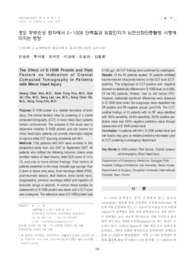

PARTNER
검증된 파트너 제휴사 자료
경도 두부손상 환자에서 S-100B 단백질과 위험인자가 뇌전산화단층촬영 시행에미치는 영향 (The Effect of S-100B Protein and RiskFactors on Indication of CranialComputed Tomography in Patientswith Minor Head Injury)
10 페이지
최초등록일 2025.04.01
최종저작일
2008.06

-
미리보기
서지정보
· 발행기관 : 대한응급의학회
· 수록지 정보 : 대한응급의학회지 / 19권 / 3호 / 303 ~ 312페이지
· 저자명 : 안승찬, 류석용, 조석진, 이상래, 오성찬, 김홍용
초록
Purpose: S-100B protein is a reliable biomarker of brain
injury. The clinical decision rules for screening of a cranial
computed tomography (CCT) in minor head injury patients
remain controversial. The purpose of this study was to
determine whether S-100B protein and risk factors for
minor head injury patients can provide meaningful insights
to improve initial CCT scanning of patients with MHI.
Methods: Fifty patients with MHI were enrolled in this
prospective study from July 2007 to September 2007. All
patients who fulfilled the following inclusion criteria were
enrolled: history of head trauma, initial GCS score of 14 to
15, and one or more clinical findings. Risk factors of
patients presented in this study included age younger than
2 years or above sixty years, focal neurologic deficit (FND),
post-traumatic seizure, skull fracture, extra-cranial injury,
coagulopathy, previous neurologic deficit and ingestion of
toxicants (drugs or alcohol). A venous blood sample for
assessment of S-100B protein was drawn and a CCT scan
was undergone. The reference value of S-100B protein was
0.105 μg/L. All CCT findings were confirmed by radiologists.
Results: Of the 50 patients studied, 15 patients exhibited
trauma-relevant intracranial lesions on the CCT scan (CCTpositive).
The subgroups of CCT-positive and -negative
showed no statistically difference in S-100B level (p=0.068).
Of the fifty patients, thirteen had no risk factors (RF).
However, statistically significant differences were observed
in S-100B level when the subgroups were classified into
RF-positive and RF-negative groups (p=0.016). The CCTpositive
findings of 13 patients with no RF were identified
with 100% sensitivity, 54.6% specificity, 28.6% positive predictive
value and 100% negative predictive value through
assessment of S-100B protein level.
Conclusion: In patients with MHI, S-100B protein level and
risk factors may give us reliable predictive information prior
to CCT screening in emergency department.영어초록
Purpose: S-100B protein is a reliable biomarker of brain
injury. The clinical decision rules for screening of a cranial
computed tomography (CCT) in minor head injury patients
remain controversial. The purpose of this study was to
determine whether S-100B protein and risk factors for
minor head injury patients can provide meaningful insights
to improve initial CCT scanning of patients with MHI.
Methods: Fifty patients with MHI were enrolled in this
prospective study from July 2007 to September 2007. All
patients who fulfilled the following inclusion criteria were
enrolled: history of head trauma, initial GCS score of 14 to
15, and one or more clinical findings. Risk factors of
patients presented in this study included age younger than
2 years or above sixty years, focal neurologic deficit (FND),
post-traumatic seizure, skull fracture, extra-cranial injury,
coagulopathy, previous neurologic deficit and ingestion of
toxicants (drugs or alcohol). A venous blood sample for
assessment of S-100B protein was drawn and a CCT scan
was undergone. The reference value of S-100B protein was
0.105 μg/L. All CCT findings were confirmed by radiologists.
Results: Of the 50 patients studied, 15 patients exhibited
trauma-relevant intracranial lesions on the CCT scan (CCTpositive).
The subgroups of CCT-positive and -negative
showed no statistically difference in S-100B level (p=0.068).
Of the fifty patients, thirteen had no risk factors (RF).
However, statistically significant differences were observed
in S-100B level when the subgroups were classified into
RF-positive and RF-negative groups (p=0.016). The CCTpositive
findings of 13 patients with no RF were identified
with 100% sensitivity, 54.6% specificity, 28.6% positive predictive
value and 100% negative predictive value through
assessment of S-100B protein level.
Conclusion: In patients with MHI, S-100B protein level and
risk factors may give us reliable predictive information prior
to CCT screening in emergency department.참고자료
· 없음태그
-
자주묻는질문의 답변을 확인해 주세요

꼭 알아주세요
-
자료의 정보 및 내용의 진실성에 대하여 해피캠퍼스는 보증하지 않으며, 해당 정보 및 게시물 저작권과 기타 법적 책임은 자료 등록자에게 있습니다.
자료 및 게시물 내용의 불법적 이용, 무단 전재∙배포는 금지되어 있습니다.
저작권침해, 명예훼손 등 분쟁 요소 발견 시 고객센터의 저작권침해 신고센터를 이용해 주시기 바랍니다. -
해피캠퍼스는 구매자와 판매자 모두가 만족하는 서비스가 되도록 노력하고 있으며, 아래의 4가지 자료환불 조건을 꼭 확인해주시기 바랍니다.
파일오류 중복자료 저작권 없음 설명과 실제 내용 불일치 파일의 다운로드가 제대로 되지 않거나 파일형식에 맞는 프로그램으로 정상 작동하지 않는 경우 다른 자료와 70% 이상 내용이 일치하는 경우 (중복임을 확인할 수 있는 근거 필요함) 인터넷의 다른 사이트, 연구기관, 학교, 서적 등의 자료를 도용한 경우 자료의 설명과 실제 자료의 내용이 일치하지 않는 경우
“대한응급의학회지”의 다른 논문도 확인해 보세요!
-
서울시 119 구급대의 병원전 응급처치 적절성 평가 12 페이지
Purpose: The purpose of this study was to evaluate the appropriateness of prehospital emergency care by 119 rescue services in Seoul. Methods: We enrolled all patients who used 119 rescue services in .. -
응급수술을 요하는 외상성 복강내출혈에서 응급실 체류시간이 사망에 영향을 주는가? 8 페이지
Purpose: Outcome for critically ill patients often depends on time-sensitive critical care interventions. Thus we examined the effects of time on the mortality and the factors affecting emergency depa.. -
심폐소생술 중 제세동 가능한 심전도 리듬으로의 변화가 예후에 미치는 영향 7 페이지
Purpose: The purpose of this study was to investigate the relationship of ECG change during CPR to outcomes in cardiac arrest patients. Methods: A total of 170 patients who received cardiopulmonary re.. -
급성 복통 응급환자에게 복부 컴퓨터 단층 촬영술을 시행할 때 금식이 꼭 필요한가? 6 페이지
Purpose: We tried to determine whether six-hour fasting before abdominal computed tomography (CT) scan is necessary to prevent aspiration of gastric contents in patients with acute abdominal pain. Met.. -
일개 대도시에서의 119 구급대가 자동제세동기를 사용한 병원 전 심정지 환자들에대한 연구 8 페이지
Purpose: To report characteristics of out-of-hospital cardiac arrest (OHCA) patients in whom 119 rescuers used an automated external defibrillator (AED) in the metropolitan area Methods: 1,689 OHCA pa..
문서 초안을 생성해주는 EasyAI
